By the spring of 2008, Russia will have a new president and parliament. Though Putin’s popularity ratings are extremely high—if elections were held tomorrow, opinion polls suggest he would win in the first round with over 50 per cent of the vote—the constitution bars him from seeking a third term. There has been much discussion in the press of candidates to succeed him—Dmitry Medvedev, First Deputy Prime Minister, is mentioned most frequently—but there can be little doubt that Putin himself will nominate his successor. It is even possible that Putin will remain as leader of the dominant party, head of government, or both. The transfer of power is therefore likely to be smooth, ensuring the continuity of the present regime. However, an examination of Russia’s recent social and economic fortunes reveals a number of problems that Putin’s successor will inherit, presenting him with a difficult agenda.
After losing 45 per cent of its output in 1989–98, the Russian economy started to expand as of 1999: gdp grew by 6 per cent that year, 10 per cent in 2000, and 4–7 per cent in 2001–06. The major impetus for this came from the devaluation of the rouble in 1998 and, later, from higher world prices for oil and gas (Figure 1); but Putin can at least take credit for not ruining this growth. Inflation fell from 84 per cent in 1998, when prices jumped after the August 1998 currency crisis and rouble devaluation, to 10–12 per cent in 2004–06.
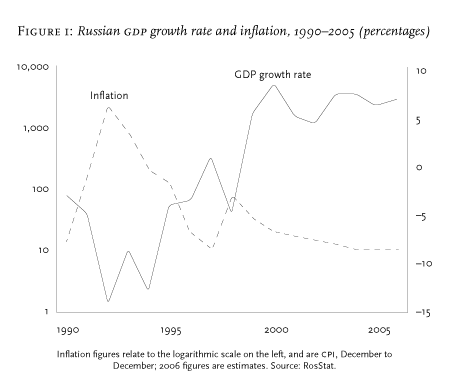
In comparative perspective, however, Russia’s performance is not that impressive. Many other former Soviet republics—Azerbaijan, Belarus, Estonia, Kazakhstan, Latvia, Lithuania, Turkmenistan, Uzbekistan and, according to some calculations, Armenia—reached or exceeded their pre-recession (1989) levels of output by 2006, whereas Russian gdp was still only at 85 per cent of the 1989 level (Figure 2). Russia’s Human Development Index (taking account not only of gdp per capita, but also life expectancy and levels of education) is still inferior to that of the ussr and even below that of Cuba, where life expectancy is 77 years, against 65 in Russia. China, with a life expectancy of 72, is rapidly approaching Russia’s hdi ranking (Figure 3).
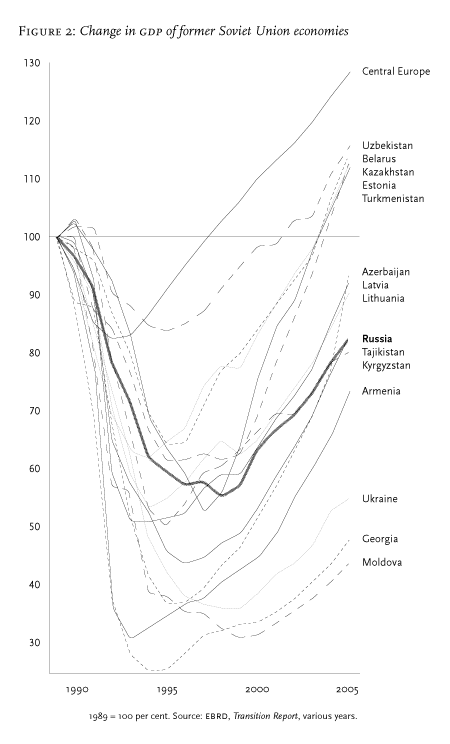
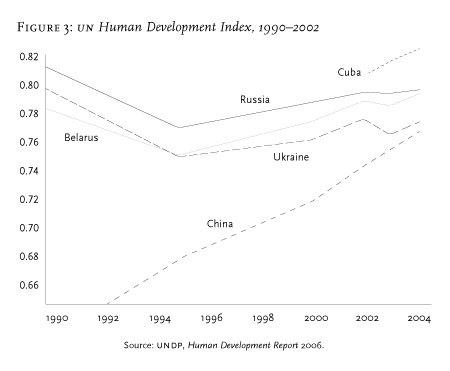
But at least there is more stability in Russia today than during the rocky 1990s. The government budget balance moved from deficit to surplus, the decline in the share of state revenues and expenditure was halted (Figure 4), government debt—domestic and external—decreased (Figure 5), and foreign exchange reserves increased to over $250 billion by the end of 2006 (Figure 6). In 2004 the government created a Stabilization Fund to hold the windfall profits from fuel exports; by the summer of 2006 the Fund contained over $80 billion. Several analysts, however, have pointed out that, given the increase in world fuel prices in recent years, one could have expected an acceleration of economic growth, rather than the slowdown that actually occurred in 2001–06 as compared to 2000.
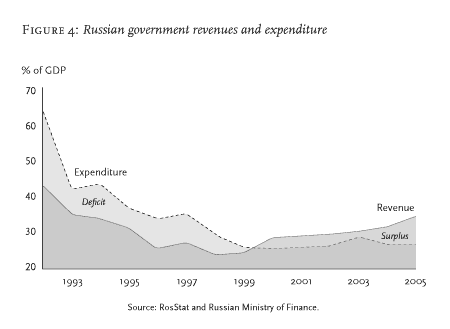
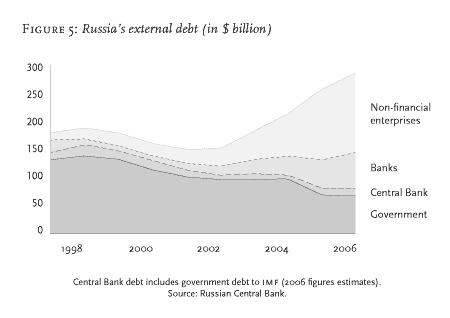
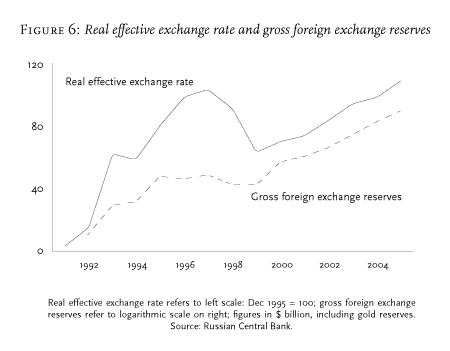
The reason for the 2001–06 deceleration in growth was the overvaluation of the real exchange rate (Figure 6, above)—the typical Dutch disease that Russia has developed once again. It first arose in 1995–98, leading to the currency crisis of August 1998, and it now seems that history is repeating itself. Optimists argue that, unlike in 1998, Russia currently has large foreign exchange reserves (over $250 billion), but pessimists point out that if oil prices drop and capital starts to flee at a rate of $5 billion a week, as it did in July–August 1998, these reserves would be depleted very quickly. A future devaluation could take the form of either a currency crisis or a ‘soft landing’, but there is little doubt that it will eventually take place.
Besides, current growth is not based on solid foundations: wages and incomes in recent years have been growing systematically faster than productivity (Figure 7), so that the share of consumption in gdp has increased at the expense of investment. As a result, whereas Russian personal and public consumption has already exceeded the pre-recession level, investment is still below 40 per cent of what it was in the last year of existence of the ussr (Figure 8). Russian gross savings are large—over 30 per cent of gdp—but they have been funnelled away via the outflow of private capital and the accumulation of foreign exchange reserves; gross investment therefore amounts to less than 20 per cent of gdp.
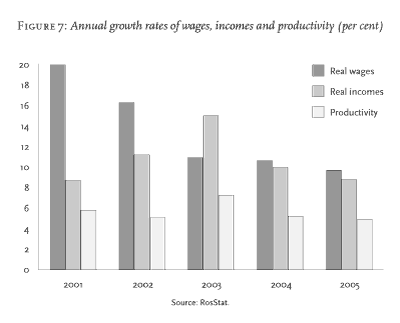
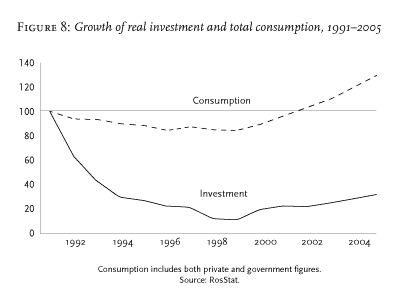
There is also another important deficiency in the current growth: the government has failed to use windfall revenues from oil and gas exports in 2000–06 to repair badly damaged state institutions and to restore the provision of crucial public goods, such as law and order, education and health care. Instead, the government cut tax rates, allowing profits from natural resources to accumulate as personal and business income, and has amassed a budget surplus. The share of state spending in gdp has barely increased at all, remaining at the extremely low level of 1999—less than half that of the ussr (see Figure 4, above).
Social trends
The inevitable economic instability of the coming years will have an important effect on future political and social developments, but perhaps less so than the dynamics of the state’s institutional capacities. A strong, efficient state is one that has the power to enforce its rules and regulations, no matter what these are. Crime and murder rates and the size of the shadow economy are natural measures of the strength of state institutions. Strong states may be more or less democratic: both China and Central European countries, with murder rates of about 2 per 100,000 inhabitants, have a stronger state than Russia, with about 25–30 murders per 100,000.
The notion of the state implies that public authorities exercise at least three monopolies: on violence, on tax collection, and on the issuing of money (coinage). All three monopolies were undermined in Russia during the 1990s to such an extent that the very existence of the state was put into question. Government failure became pervasive and much more visible than market failure. In 1998, just before the currency crisis, the payment system was on the brink of collapse: barter deals exceeded 50 per cent of total transactions and enterprises were accumulating non-payments (trade, tax and wage arrears), delaying sums owed to the government, their partners and their workers. After economic growth resumed in October 1998, non-payments and barter transactions quickly disappeared, but there is no guarantee they will not rise again, if the authorities resort to tight monetary policy.
Tax collection, after falling dramatically in 1992–98, increased slightly (see Figure 4, above), but mostly due to the resumption of growth, rather than better tax compliance. Government efficiency has not improved in recent years: different measures of corruption, government effectiveness and rule of law, though inevitably subjective in nature, concur in registering a lack of significant progress (Figures 9–12). Low spending levels, moreover, mean that the state simply cannot provide enough public goods.
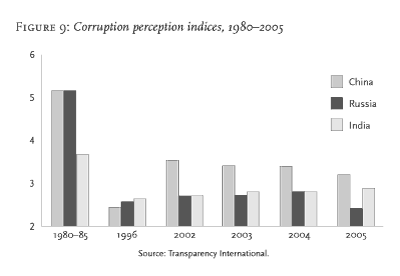
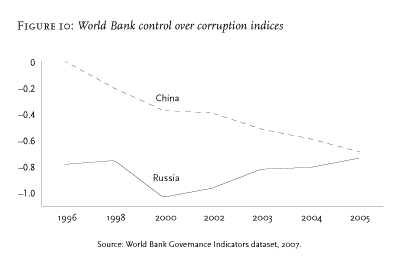
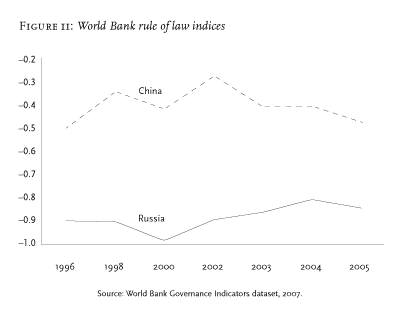
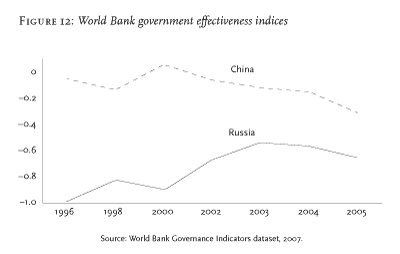
But worst of all, the scale and scope of criminality in Russian society remains vast. The crime rate rose gradually in the Soviet Union as of the mid 1960s, but after the collapse of the ussr there was an unprecedented surge—in just a few years crime and murder rates doubled, equalling or surpassing the highest levels in the world (Figure 13).footnote1 By the mid 1990s the murder rate stood at over 30 per 100,000 inhabitants, as against 1–2 in Western and Eastern Europe, Canada, China, Japan, Mauritius and Israel. Only two countries (not counting some war-torn collapsed states in developing countries, where there are no reliable statistics anyway) had higher murder rates—South Africa and Colombia—whereas in Brazil and Mexico, the figures are 50 per cent lower than Russia’s. Even the us murder rate, the highest in the developed world—6–7 people per 100,000—pales in comparison with that of Russia.
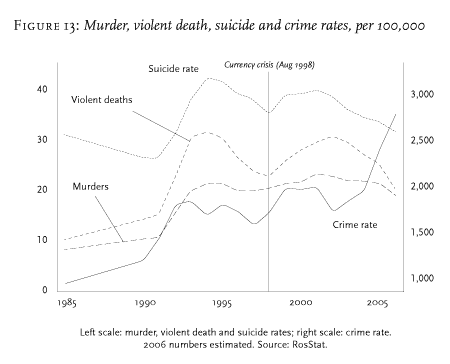
When the murder rate reaches 40–50 people per 100,000, as it did in Colombia in the 1990s, the country faces a complete collapse of state authority and a decline into chaos and warlordism. The unprecedented increase in the crime rate in the 1990s, the shocking—but unpunished—murders of high-profile politicians, businessmen and journalists, left Russia’s law enforcement agencies morally bankrupt and brought the state to the brink of losing its monopoly on violence.
The Russian rate of deaths from external causes (accidents, murders and suicides) had by the beginning of the twenty-first century skyrocketed to 245 per 100,000 inhabitants. This is higher than in any of the 187 countries covered by who estimates in 2002 (see Table 1). It is equivalent to 2.45 deaths per 1,000 a year, or 159 per 1,000 over 65 years, which is the average life expectancy in Russia today. Put differently, if these rates continue to hold, 1 out of 6 Russians born in 2002 will have an ‘unnatural’ death. To be sure, in the 1980s murder, suicide and accidental death rates were quite high in Russia, Ukraine, Belarus, Latvia, Estonia, Moldova and Kazakhstan—several times higher than in other former Soviet republics and in East European countries. However, they were roughly comparable to those of other countries with the same level of development. In the 1990s these rates rapidly increased, far outstripping those in the rest of the world.
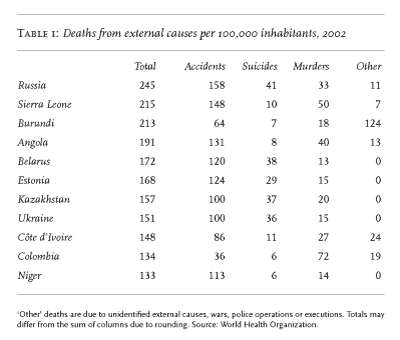
The most important achievement of recent years is the improvement in social trends brought about by economic growth and political stability: the number of murders reached a peak in 2002 and fell in 2003–06; the suicide rate decreased in 2001–06 (Figure 13, above); the mortality rate stopped growing in 2004 (Figure 14); after reaching a 50-year low in 1999, the birth rate started to grow, the marriage rate increased and the divorce rate fell. On the other hand, a nearly 60 per cent increase in the crime rate in 2002–06 is most likely a sign of better recording of crimes. True, the improvements are very marginal, and have only appeared in the last two or three years, but at least there is a ray of hope that was previously entirely absent.
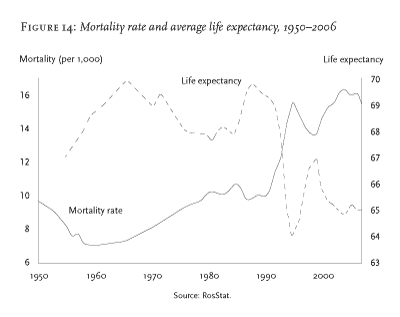
Rebuilding the state?
The victory of ‘Yedinstvo’, the ‘party of power’, in the parliamentary elections of 1999 was, among other things, a victory for the have-nots (subsidized regions) over the haves (donor regions), which had joined forces in the Primakov–Luzhkov bloc ‘Otechestvo–Vsya Rossiya’. Putin tried to limit the all-powerful regions by changing the principles of fiscal federalism, appointing presidential viceroys in seven amalgamated regions and reforming the Federation Council, the upper chamber of the Russian parliament, which represented the interests of all 89 regions. In 1999, Putin began a second war against Chechnya, refusing to negotiate with the separatists, who are today largely defeated. He launched court cases against the ‘oligarchs’—remaining within the limits of the law. A series of tycoons were accused of tax evasion and financial machinations; some emigrated, some were arrested. The only non-governmental television channel, ntv, was shut down (incidentally, also for totally legitimate reasons: the ‘oligarch’ Gusinsky had refused to pay his debt to the state-owned Gazprom, having seemingly decided that freedom of speech was not worth that much money). Mikhail Khodorkovsky ended up in jail for fraud (taking oil profits to offshore locations via transfer pricing), and his company, Yukos, was bankrupted by the government; its assets were seized in place of the tax arrears destined for state coffers. Another oil company, Sibneft, was purchased on the open market by Gazprom, raising the state’s share in the oil industry from less than 15 per cent in 2004 to over 30 per cent a year later.
But the improvement in social indicators has been the most important achievement of all. Economic growth and low inflation alone cannot prevent the disintegration of the country if social inequality and crime increase. Building the vertical of power and intensifying centralization may not prevent the collapse of the state, if they do not establish law and order more firmly and limit the extent of the shadow economy. In fact, Putin has been criticized precisely for taking ever more power into his own hands without greater order resulting. But it now seems that the first signs have appeared of a real, rather than an ephemeral, stabilization.
Putin’s popularity can be explained primarily by his ability to stop the collapse of the state caused by the reforms of the 1990s. All other problems are dwarfed by the threat of social and national disintegration. The majority of Russian citizens are prepared to forgive Putin for his heavy-handed tactics in dealing with the ‘oligarchs’ and even with entrepreneurs of a lesser stature, for the ‘purges’ in Chechnya, and for the constraints placed on democracy and freedom of speech—all in the interests of strengthening law and order and curbing the boundless anarchy of the 1990s.
Polls conducted on the eve of the February 2004 elections asked Russians what they expected first and foremost of the new president. Fifty-eight per cent wanted him to restore Russia to its status as a great and respected power; 48 per cent to ensure a just distribution of income in the interests of ordinary people; 45 per cent to strengthen law and order; 43 per cent to put an end to the war in Chechnya; 41 per cent to return the money that ordinary people lost during the reforms; 39 per cent to strengthen the role of the state in the economy. Such priorities as ‘keeping Russia on the road of reform’ and ‘continuing the policy of closer ties with Western countries’ garnered only 11 and 7 per cent respectively. ‘Are you concerned that Putin could establish an iron-fisted dictatorship supported by the “power agencies”?’ In January 2000, before Putin’s first electoral victory, 34 per cent said yes to this question, while in January 2004, only 26 per cent held this view. Respectively, 57 and 67 per cent showed no concern.
Prospects
Where is Russia headed? The future harbours many dangers. The current real exchange rate of the rouble (the ratio of domestic to world prices) is too high. It has been growing throughout the past five years and in 2006 exceeded the 1998 pre-crisis level. Therefore, a drop in world energy prices could easily provoke a new currency crisis and interrupt economic recovery, despite large currency reserves. Domestic fuel and energy prices remain many times lower than world levels, creating incentives for inefficient energy consumption; Russia has one of the highest ratios of energy use to gdp in the world. Unlike in Eastern European countries and many of the former Soviet republics, where the prices of fuel and energy have already reached or are approaching world levels, the restructuring of the Russian economy is still far from complete. What Russia should have done in recent years was to slowly devalue the rouble, and at the same time increase domestic prices for oil, gas and electricity, compensating producers for losses from the rising cost of energy with the stronger competitiveness that would result from the depreciating rouble. However, such a policy is not even on the drawing board at present.
A second danger is too rapid a decrease in taxes, which the government has already implemented (income tax, corporate tax and the unified social tax). Critics of such measures, including the imf’s Moscow office, justifiably point out that the current budget surpluses are based primarily on high prices for energy resources, and therefore, if these prices should fall, the government could once again find itself penniless. Moreover it is not the right time to reduce taxes when virtually all government services—health care, education, defence, law and order—are much worse off than the private-sector economy.
Other dangers remain: corruption, the inefficiency of the state apparatus, high levels of social inequity. But generally Russia is in better shape today than seven years ago, when Putin assumed power. Russia now needs more than anything to strengthen law and order and to restore the institutional capacity of the state. Democracy is also needed, but only later, when the rule of law has been established. There is, of course, a danger that the leadership will use political centralization to line everyone up along the ‘vertical of power’ and eliminate opposition in order to live in serene comfort at the citizens’ expense—and perhaps also to embark on the occasional escapade. This has happened in Russia before. But one must choose the lesser of two evils. Strengthening law and order is only possible under a centralized system. Without centralization, there is no chance at all of it happening; unbounded chaos and lawlessness would rule. This seems to be the choice facing Russia today.